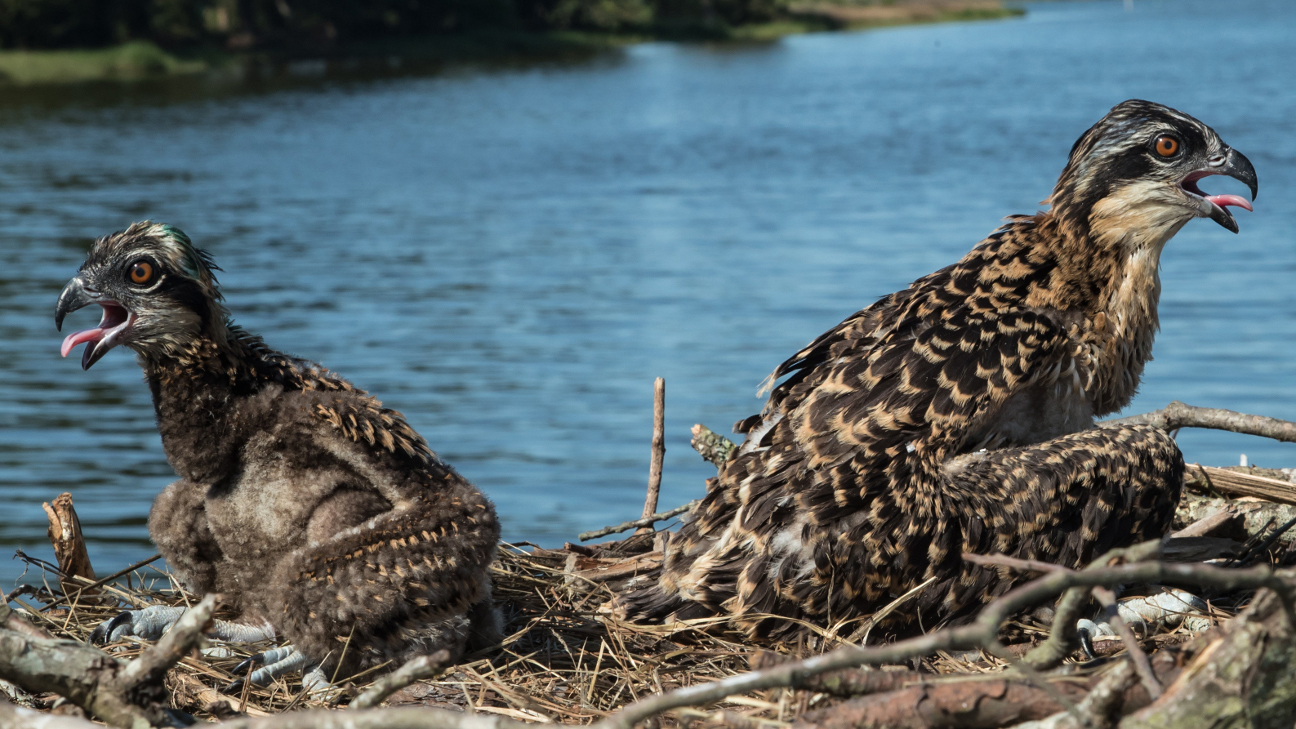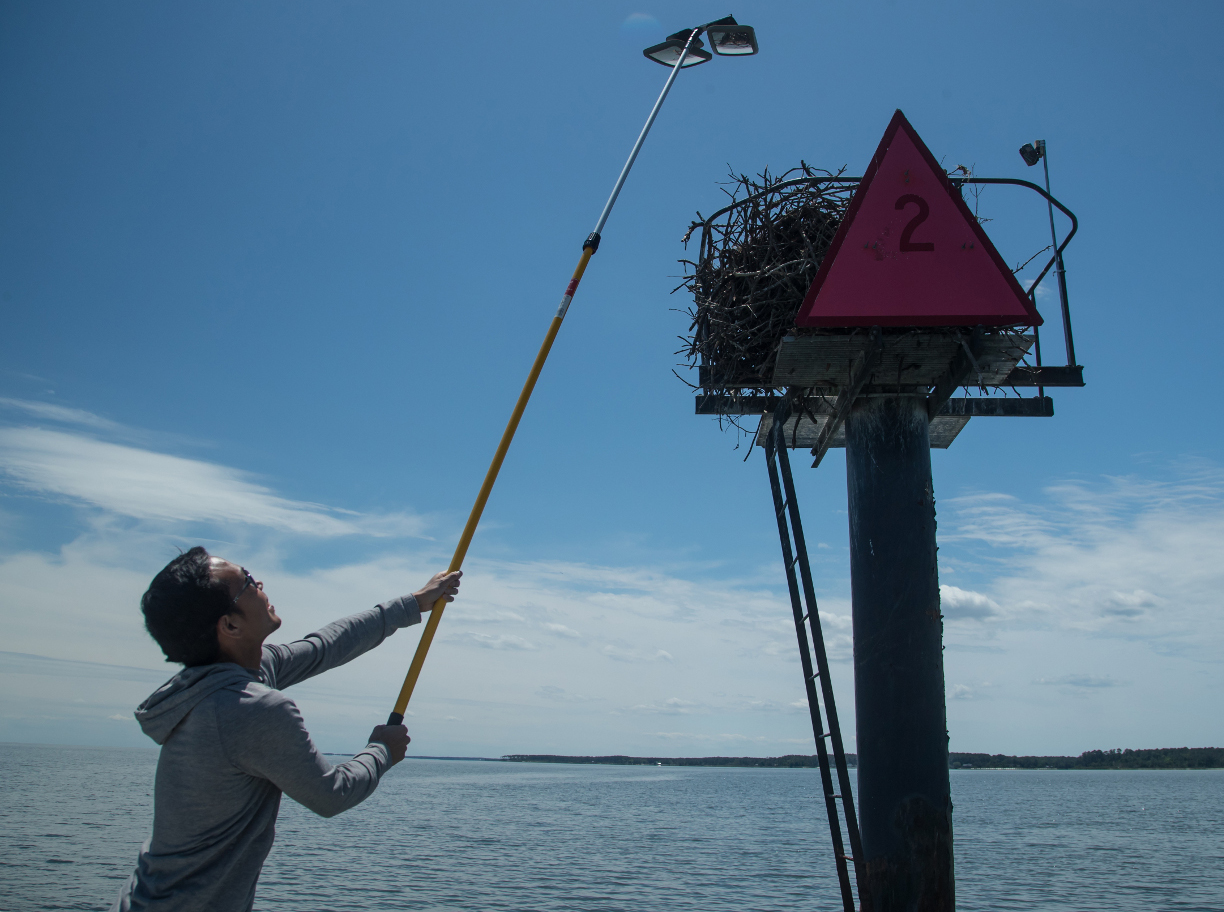Osprey chicks are starving in the Chesapeake Bay, researchers say — and controversial menhaden harvest may be to blame

An osprey nest in the Chesapeake Bay. (Photo courtesy of Bryan Watts)
Osprey come to the Chesapeake Bay each spring to feed on fish and nest their young.
The large hawks have become a familiar sight to waterfront homeowners who like to keep track of nests near their property, said Bryan Watts, director of William & Mary’s Center for Conservation Biology.
But Watts and his colleagues have increasingly heard from residents worried about the birds’ fate after seeing fewer of them.
The biology center’s new research confirms those concerns. They found that osprey in the lower Chesapeake Bay are failing to successfully reproduce.
It’s the lowest number of osprey chicks that officials have seen since the information started being recorded in the 1970s.
“We suspect that has been going on for at least 15 years or so,” Watts said. “But it does seem to be getting worse in that more and more nests are failing.”
The researchers focused on Mobjack Bay along the Middle Peninsula because it’s been heavily studied over the years, Watts said.
He and his graduate students regularly surveyed the population using mirrors attached to poles that peek into the tall nests.

William & Mary researchers use pole-mounted mirrors to check on osprey nests in Mobjack Bay.
They found the reproduction rate to be about .13 per pair of osprey – meaning only about one in 10 of the bird couples successfully produce offspring.
In order for the population to sustain itself, pairs should produce an average of 1.15 young per pair, he said.
The current situation is even worse than what was recorded during the height of the “DDT era” in the 1970s, Watts said, when the widely used pesticides suppressed osprey hatching.
In that era, the female osprey’s eggs were affected. Right now, chicks are being hatched but often starve, Watts said.
Osprey eat a range of fish including anchovies, sardines and herring. But their biggest source of food is the tiny but nutrient-dense menhaden, Watts said.
The William & Mary researchers believe the osprey’s steep decline is due to increasing scarcity of menhaden tied to overharvesting.
The findings thus touch on the “political minefield” of regulating the menhaden harvest in Virginia, Watts acknowledged.
For many years, lawmakers in Richmond controlled those regulations directly, the only fishery not under the jurisdiction of the Virginia Marine Resources Commission. That changed in 2020 and the VMRC gained control.
Virginia is the last place on the East Coast that allows menhaden reduction fishing.
Omega Protein catches the fish in both the Chesapeake Bay and the Atlantic Ocean and “reduces” them into oil or fishmeal at a facility in Reedville.
Environmental and sportfishing groups have been pushing in recent years for a total ban on the menhaden harvest in the bay, arguing that it’s taking away the important fish from other species, including striped bass and osprey.
Omega has successfully evaded such a ban, but agreed earlier this year to some voluntary, non-enforceable limitations.
The Canadian-owned company argues there is no evidence of overfishing menhaden, pointing to assessments by the Atlantic States Marine Fisheries Commission that have concluded as much. Those advocating for a ban say those assessments don't focus on the Chesapeake Bay specifically.
In an interview with WHRO last year, Omega spokesperson Ben Landry called menhaden overharvesting a “dreamed-up concept.”
Watts at William & Mary said he wants to see a policy that “protects the ecosystem first and industry second.”
“Osprey don’t have a political or economic agenda here. They’re just trying to do their thing,” he said. “They’re sort of the collateral damage to the politics.”
Other factors can affect osprey numbers, such as predators and weather, he said. But the researchers believe the connection they make is well-documented.
In 2021, the group experimented with supplementing some nests with more menhaden, and found that it lowered starving rates.

An osprey feeds its chick in a nest.
Watts estimates the osprey population would need menhaden levels to return to where they were in the 1980s.
The researchers plan to expand their observations to see how widespread the issue is in the lower Chesapeake.
Osprey further north in less salty areas of the bay — such as the headwaters of the Potomac and Rappahannock rivers — seem to be faring well, Watts said. They rely on catfish, gizzard shad and other fish species.
Many people seem to recognize the birds’ integral role in the area, he said.
“They’re like blue crabs or oyster or salt marshes. They’re something that’s just interwoven into our culture here.”
If you are interested in helping the ospreys, you can contact (macademia@wm.edu).














